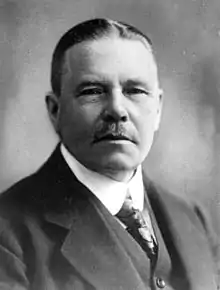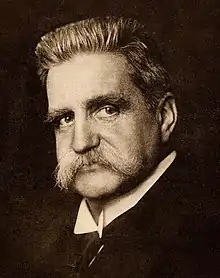| |||||||||||||||||||||||||||||||||
All 230 seats in the Riksdag | |||||||||||||||||||||||||||||||||
|---|---|---|---|---|---|---|---|---|---|---|---|---|---|---|---|---|---|---|---|---|---|---|---|---|---|---|---|---|---|---|---|---|---|
| |||||||||||||||||||||||||||||||||
| |||||||||||||||||||||||||||||||||
.svg.png.webp) |
|---|
Early general elections were held in Sweden between 27 March and 7 April 1914,[1][2] after the Riksdag had been prematurely dissolved by the Cabinet of Hjalmar Hammarskjöld.[3] The General Electoral League emerged as the largest party, winning 86 of the 230 seats in the Second Chamber.[4] As of 2022, this is the last time a Swedish election has not seen the Social Democrats win a plurality of seats.
Results
.svg.png.webp) | |||||
|---|---|---|---|---|---|
| Party | Votes | % | Seats | +/– | |
| General Electoral League | 286,250 | 37.65 | 86 | +22 | |
| Free-minded National Association | 245,107 | 32.24 | 71 | –31 | |
| Swedish Social Democratic Party | 228,712 | 30.09 | 73 | +9 | |
| Other parties | 125 | 0.02 | 0 | 0 | |
| Total | 760,194 | 100.00 | 230 | 0 | |
| Valid votes | 760,194 | 99.58 | |||
| Invalid/blank votes | 3,229 | 0.42 | |||
| Total votes | 763,423 | 100.00 | |||
| Registered voters/turnout | 1,092,454 | 69.88 | |||
| Source: Nohlen & Stöver | |||||
References
- ↑ Nohlen, D & Stöver, P (2010) Elections in Europe: A data handbook, p1858 ISBN 978-3-8329-5609-7
- ↑ "Riksdagsmannavalen våren 1914 av Kungl. Statistiska centralbyrån - Valstatistik-Riksdagsmannavalen-1914.pdf" (PDF) (in Swedish). Statistiska Centralbyrån. Retrieved 22 June 2020.
- ↑ Nohlen & Stöver, p1864
- ↑ Nohlen & Stöver, p1871
This article is issued from Wikipedia. The text is licensed under Creative Commons - Attribution - Sharealike. Additional terms may apply for the media files.


